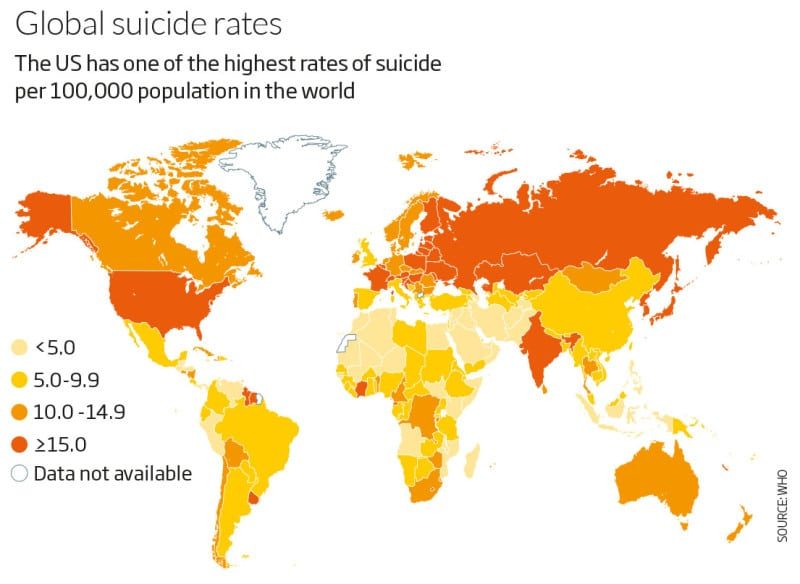A number of explanations have been put forward, including the 2008 economic crash, the upsurge in addiction to opioid painkillers and the migration of manufacturing jobs to other countries. But none alone explains why the suicide rate is rising so fast in the US as it falls in other rich countries. Is something uniquely American at work?
Figures from the US Centers for Disease Control (CDC) show the country's rate of suicide was 15.6 per 100,000 population in 2016, up from 12.2 in 1999. Of all the states, Montana fares worst, with a rate of 29.2 per 100,000. The global average rate in 2016 was 10.6, according to the World Health Organization.
For comparison, the rate for the UK in 2016 was 8.9 per 100,000, down from 9.1 in 2000, according to the latest WHO data. And although rates are much higher in Russia, at 31 per 100,000 in 2016, this is a dramatic fall from 52.6 in 2000. Clearly, the US is something of an outlier.
Comment: And clearly - contrary to American prejudice - Russia is doing something right, i.e. at least they're moving in the right direction.
Globalisation and automation, which are driving job losses in the US, may partly be to blame, but the same pressures have affected all Western economies without a similar increase in the suicide rate.
People who work in mental health and suicide risk contacted by New Scientist argue that some distinctive elements of US culture may help to explain the rise. "I think the US is unique in a few respects," says Julie Phillips of Rutgers University in New Jersey, who studies suicide risk.
One of the key drivers could be the American dream itself - the idea that you can work hard and climb out of poverty. A growing mismatch between the life expectations this brings and the increasingly bleak reality for many US citizens could lead to hardship.
This may be particularly felt by middle-aged white Americans, who have the highest suicide rates and the steepest rises. The American dream is deeply ingrained, but it no longer seems to be true for working class, middle-aged people, says Phillips. "I think this disjuncture between norms, expectations and reality is one important factor behind the increase."
Troubled times
This group is also more likely to be negatively affected by divorce, lower education levels and economic inequality. Among US adults over 50, the divorce rate has doubled since the 1990s, says Phillips. In 1999, suicide rates for middle-aged people with a high-school diploma or less were 1.7 times greater than those with a college degree. By 2013, this difference in risk had risen to 2.4 times greater.
It is also likely that recent events, such as the 2008 financial crash and the current opioid painkiller crisis, are contributing to the rise in the suicide rate. "We know suicides increase in times of economic turmoil," says Deborah Stone of the CDC, and lead author of this month's report. "Data also indicate that opioid prescribing rates are higher in counties where there are higher rates of suicide."
Strong individualism in the US and the lack of social welfare schemes found in many other rich countries may also play a role.
Evidence for this comes from a 2013 report that showed people in the US die earlier than those in comparable nations, though not necessarily from suicide. The joint report by the US National Research Council and the Institute of Medicine revealed that by almost every measure, people in the US were unhealthier and more likely to die prematurely than those in 16 other rich nations.
"The problem has deep roots," says Steven Woolf at Virginia Commonwealth University, who headed up the report. "We believe living conditions are producing a growing sense of desperation that's causing people to turn to drugs and alcohol and, when all hope is lost, suicide."
The report also highlights the fact that, unlike the US, governments of rich nations such as Finland, France and Belgium promote healthcare through non-medical support, including housing, education and social insurance. "The US spends plenty, but we spend differently," says Laudan Aron at the Urban Institute in Washington DC.
This rejection of the state and the prioritising of individual rights, no matter the potential costs, runs right through US culture. It explains why people in the US are more likely to indulge in risky behaviours such as over-eating and gun-related activity, and tend to defy safety-based but restrictive norms such as wearing seatbelts. So could this attitude also be behind US suicide rates?
Stone agrees it may have played a part. "It is possible that the culture around individualism and stigma around seeking help does leave people vulnerable, perhaps more so than in other Western countries, but that needs additional study," she says.
Others are more convinced. "The group most affected - less educated, white, middle-aged males - grew up with certain norms surrounding masculinity and self-reliance, and this group doesn't seem to be seeking help," says Phillips.
To redress the increasing rates, Stone says the CDC has issued guidance on preventing suicide. It has recommended social and economic support measures such as providing financial help with paying rent, teaching skills for coping with stressful events and relationship problems, and encouraging a sense of belonging and social connectedness among vulnerable people (see "Reporting suicide").
But Woolf says more radical interventions are needed. "Policymakers need to address widening social inequalities that are placing a vice on the middle class, and relieve the distressful living conditions that are driving people to their deaths," says Woolf. Instead, they are doing the opposite. "Current elected officials are pulling funding out of such programmes and enacting new policies which, if anything, will tighten the vice," he says.





Jesus F*****g Christ, OF COURSE! Duh.
R.C.